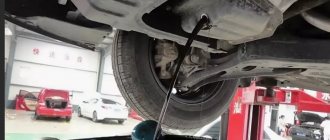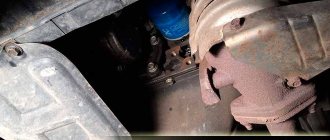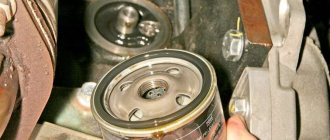As popular wisdom says: “You can’t spoil porridge with butter.” This is also true for a car. Regular oil changes in the VAZ 2106 engine are an essential condition for the long-term operation of any car.
Even the VAZ 2106, which is considered an almost “indestructible” legacy of the Soviet automobile industry, needs regular lubricant changes. How to independently change the oil in a VAZ 2106? How often should this be done and what brand of liquid is best to use?
Oil change intervals
Lubricating oil is designed to protect the engine, gearbox and rear axle gearbox from wear and damage. Without it, the engine, gearbox and other parts will quickly become unusable. However, heat-resistant liquid has a limited resource, so it needs to be changed regularly, the more often the better. The frequency of replacement depends on several factors:
- Intensity of vehicle use.
- Driver's driving style.
- Season of operation.
- General condition of the car.
There are also standard standards that tie the frequency of oil changes in the VAZ 2106 to a certain mileage. For an engine it is every 10 thousand km, for a gearbox – 40 thousand km, for a gearbox – 15 thousand km.
What to focus on: calendar, odometer, engine hours?
When the car is under warranty service, it is best to entrust all issues related to changing the oil to service technicians. The further procedure for changing the oil yourself largely depends on the operating conditions.
Conventionally, drivers can be divided into several groups: summer residents, weekend drivers and city guests. The former drive extremely rarely; the car sits idle most of the time. The latter travel only from Friday to Sunday, and the driving is mainly suburban. But city guests are motorists who burn through fuel every day in the city. Not a single traffic jam is complete without them.
What recommendations can be given to these groups of drivers? Summer residents can change the oil based on the calendar. When the annual mileage is only a few thousand kilometers, the manufacturer recommends changing the technical fluid once a year. That is, it’s time to replace it according to the calendar, change the oil and filter.
If the car is driven mainly on weekends, and then mostly outside the city (operating conditions are close to ideal), then when changing the oil you can follow the manufacturer’s recommendations - 10 to a maximum of 15 thousand kilometers. Residents of large cities should remember that their cars are subject to high loads. The engine is not operating under optimal conditions. With daily driving in the city (25-30 km/h) 10-15 thousand km, not a single modern oil can withstand.
Important!
If the car is operated in urban mode, the manufacturer's recommendations on frequency should be divided by two. This means that the technical fluid should be changed every 5-7.5 thousand
km run.
But it may also be that the car’s engine works a lot, but the mileage is low. In this case, it is better to focus not on mileage, but on engine hours. At any auto store you can purchase a meter that calculates engine hours and install it in your car with automatic engine start.
Oils based on hydrocracking can withstand 200-250 operating hours, and those based on PAO - 300-350 operating hours.
What oil should I use?
What lubricant should I use? This is a key issue, especially when it comes to operating a car in the cold season. Many drivers have encountered a situation where the oil “freezes,” causing considerable trouble. Therefore, you should approach the choice of oil very seriously, without relying on advertising.
There is a myth that good lubricant is very expensive. This is wrong. Of course, advertised brands are more expensive, but among the budget domestic options there are worthy analogues that have excellent performance.
Lubricating oils are divided into mineral, synthetic and polysynthetic. Mineral options are low cost, but they are the ones most susceptible to temperature changes. Synthetic and semi-synthetic analogues are more resistant to Russian frosts and also better protect the car engine. The main selection criterion is the viscosity of the heat-resistant liquid. There is a viscosity classification, according to which there are summer, winter and off-season oils.
Tools and accessories for replacement
Changing the oil in a VAZ 2106 is a procedure that the driver can carry out independently. However, for this you need to have some tools and devices. First of all, it is important to understand that it is necessary to provide a convenient approach to the car from below. To do this, you can use various options: a lift, an inspection hole, an overpass, etc.
To change the oil you need to have some tools, including:
- Hexagon 12. It is necessary for installing drain plugs.
- The key is 17. It is needed to install the filler plugs.
- A convenient watering can with a wide neck, through which liquid is poured into the holes.
- Container for waste material.
- Protective equipment and cleaning cloth.
- Consumables are the lubricant itself and a new oil filter.
Changing the engine oil
To briefly describe the process of changing the oil in a VAZ 2016 engine, you need to drain the used material and fill in a new one. This process is not difficult, you just need to follow the correct sequence of actions. You only need to change the lubricant when the engine is warm, so you need to be careful and use protective gloves.
Changing engine oil consists of several points:
- Unscrew the drain plug, which is located in the engine sump, after placing some container under it. The plug can be unscrewed using a hexagon or wrench. After all the old fluid has drained, you need to install the plug back.
- Replace the oil filter. You can try to unscrew the old filter by hand, but if it is firmly seated, then you need to use a special puller. The new filter must be screwed into the same hole.
- Open the filler neck, which is located on the engine cover. Insert a wide-necked watering can into the hole and slowly pour new oil through it. Be careful and constantly monitor the level of liquid in the canister itself. In total, you need to fill in approximately 3.7 liters of new lubricant.
- Determine the amount of oil poured. To do this, you need to take out the oil dipstick, wipe it clean, put it back into the engine and remove it. The level should be in the middle of the two marks; small deviations are allowed. When the required amount has been filled in, you need to screw the cap back on.
- Conduct a test run. To do this, you need to start the engine and let it run for a few minutes. A light on the panel will light up for a while, indicating oil pressure. After a few minutes, turn off the engine and check the fluid level again with the dipstick. If it has decreased, then you need to add the required amount until the above-mentioned mark is restored.
Some drivers recommend changing the oil with flushing oil. As practice shows, this does not make a significant difference.
Therefore, if you have the opportunity to do additional washing, there is nothing wrong with that, but even without this, problems should not arise.
About types of transmission oils
Today, two types of gear oils can be found on the fuel and lubricants market: GL-5 standard oil and GL-4 standard oil. Here are their differences:
- GL-4 standard. These are transmission oils used in gearboxes and drive axles with hypoid and bevel gears operating at moderate temperatures and loads;
- GL-5 standard. It includes transmission oils used in high-speed axles and gearboxes operating under conditions of high temperatures and alternating shock loads.
From the above, it becomes clear that the GL-5 standard provides better extreme pressure protection for the gears in the transmission. But this is a common misconception to which many car owners, including VAZ 2107 owners, are susceptible.
Let's take a closer look at this point.
Transmission oils of the GL-5 standard use special complexes of sulfur-phosphorus additives, which create an additional protective layer on the rubbing steel parts of the gearbox. But if such an additive comes into contact with parts containing copper or other soft metal, then the protective layer formed by the additive turns out to be stronger than the copper surface. As a result, wear on the soft metal surface accelerates several times.
Research shows that the use of GL-5 standard lubricant in gearboxes that require GL-4 standard lubricant is not only not advisable, but also dangerous. For example, synchronizers in VAZ 2107 boxes are made of brass. And with prolonged use of GL-5 oil, they will be the first to fail. It is for this reason that the owner of a VAZ 2107 should fill only GL-4 standard oil into the gearbox.
The second most important point that the owner of a VAZ 2107 should remember is the viscosity class of the oil being poured. Today there are two such classes:
- class SAE75W90. It includes semi-synthetic and synthetic transmission oils, which motorists call all-season. This lubricant works in a wide temperature range - from -40 to +35°C. It is this class of oils that is ideal for use in our country;
- class SAE75W85. The upper temperature limit for oils of this class is higher. But it should not exceed 45°C, since at this temperature the oil begins to boil.
Changing gearbox oil
Work on a gearbox involves almost the same steps as replacing an engine.
It consists of the following steps:
- Drain the waste fluid from the crankcase. To do this, place the container under the drain plug, which can be unscrewed with the same 12mm hexagon. After all the liquid has drained, screw the plug back on.
- Unscrew the plug on the crankcase filler hole using a 17mm wrench. You can use a small syringe to fill the oil. Unlike changing the lubricant in the engine, in this case you need to fill it until it completely fills the crankcase, until it flows out of the filler hole. After this, screw the plug back. A 4-speed gearbox requires 1.4 liters, and a 5-speed gearbox requires 1.7 liters.
- Inspect the crankcase for leaks and other damage. To do this, you need to thoroughly wipe the crankcase with a dry cloth.
Important: if you find metal dust or metal shavings in the drained material, this is a signal of a malfunction in the gearbox and the need for urgent repairs.
Factors affecting the service life of motor lubrication
Age
If you have purchased a new car and, accordingly, the engine is going through the break-in stage, you must strictly follow the recommendations of the car manufacturer. It is important to know that proper engine break-in directly affects its service life in the future. During this period, approximately 5000-7000 kilometers, you should not “drive” at maximum speed and the main thing is to try to avoid overheating of the engine. When changing the lubricant after running the engine and in the future, it is better not to save money. Such savings at first glance will cost you dearly in the future (frequent engine repairs). The engine, for your conscientious care, will repay with reliability and a long service life. If your car is used and has a lot of mileage on the odometer, you need a different approach. You should not trust the statements of the previous owner (seller) that his car was operated carefully and carefully, that he changed the lubricant only yesterday. It is better to replace the lubricant in the engine and the filter right away, be sure to use a flush (you don’t know exactly what kind of oil the previous owner filled in and how long ago, it’s unlikely that it was yesterday, before selling the car they could have saved money on oil and filled it with the cheapest one). We recommend that you seek help from a good auto mechanic who can assess the general condition of your car, and its engine in particular. It is stupid and wasteful to use expensive oil in an engine whose operation produces a strange knocking or noise. In addition to this, it may have an excessive appetite and “eat” oil, then your money will literally go down the drain. If you are lucky and have avoided these troubles, the engine works “like a clock,” then all you have to do is change the lubricant more often at first. Over time, the frequency of replacement can be increased, but this is subject to the use of high-quality motor oils.
Intensity of use
Many owners believe that if they use the car as little as possible (for example, once a week or a month), then the car will last much longer than one that is used daily. In fact, they are mistaken! For example, if you do not start the engine for a long time, condensation appears in it, it disrupts the composition of the lubricant and creates an aggressive environment that accelerates the process of engine destruction. This means that very soon you will need to change the lubricant to avoid big problems. As you can see, a long downtime of a machine does not at all increase the service life of the engine and reduces the interval between lubricant changes. Based on this, we conclude that it is more favorable to have a constant low mileage of the machine and timely oil changes after a regulated number of kilometers. Rather than keeping the car in the garage (or in the parking lot) for a long time and changing the lubricant in the engine after a couple of weeks or months.
Driving style
On this point, we can definitely say only one thing: if you like to “squeeze” everything out of the car (“start with a slip” at an intersection, “accelerate” the engine to maximum while walking along the highway), accordingly the car will require more attention from you. To somehow make life easier for the engine, even frequent replacement of lubricant is not a sufficient measure! The oil must be semi-synthetic or fully synthetic and of course high quality.
Seasonality
You should definitely know and remember about the seasonal (winter-summer) features of the use of oils. For example, fill in “summer” oil before the onset of winter, then don’t be surprised that at just -15 C the car won’t start at all and the starter has difficulty cranking the engine. This is a heavy blow not only to the engine of your car, but also to your nerves.
Conclusion: When filling in lubricant, be sure to take into account the climatic conditions of your area.
Lubricant quality
The quality of the oil used directly affects not only the increase in engine life, but also the increase in the interval between replacements, almost twice as long. If you use inexpensive mineral oil, the replacement is made after 5000-7000 kilometers. In the case of high-quality and expensive synthetic oil, this interval increases to 10,000 - 15,000 kilometers. Just when purchasing lubricant, be careful not to fall for counterfeit scammers or unscrupulous sellers who will slip you an outright “fake”, hiding behind branded packaging.
Gasoline quality
We will not talk about the low quality of even factory-made gasoline, which is widespread in our time, or about all the known chemical “treatments” of fuel at gas stations. This is a separate sore subject. However, it is worth remembering that low-grade gasoline with an abundance of additives and foreign impurities disrupts the composition of the lubricant in the engine. All additives that do not burn get into the oil, it darkens, thickens and pollutes the engine.
Conclusion: it is necessary to use a brand of gasoline that complies with the manufacturer’s instructions and be careful when choosing a gas station. Otherwise, you risk significantly reducing the service life of the engine.
Using our recommendations, you can independently determine the frequency of lubricant changes and significantly extend the life of the “heart” of your car. Recommended viscosity 10W-40.
Changing the oil in the rear axle gearbox
Changing the oil consists of the following steps:
- Unscrew the drain plug using a hexagon. Drain the waste material into the container and screw the cap back on.
- Unscrew the filler plug with a 17mm wrench. Pour liquid into the gearbox until it flows through the filler hole. This can be conveniently done using a special syringe. Often about 1.3 liters of oil is enough. Screw the plug back.
From the above instructions it is clear that changing the oil in a VAZ 2106 is a simple and quick process that you can do yourself. By carrying out timely lubricant changes, you will ensure good performance of your car and increase its service life, as well as minimize the likelihood of breakdowns and the need for repairs at the most inopportune moment.
Replacing the oil pump drive gear on a VAZ 2106
If the “oil pressure” indicator on the instrument panel in your six constantly lights up, there may be several reasons for this. The first reason is lack of oil. If after changing the oil the indicator continues to glow, the fault is most likely in the oil pump, or rather its gears. Replacing the VAZ 2106 oil drive gear:
- To get to this gear you need to remove the ignition distributor breaker.
- Before removing the distributor, it is necessary to set the crankshaft to the desired position.
- We unscrew the spark plug of the first cylinder.
- The hole in the first cylinder must be plugged with a finger.
- We turn the crankshaft until air comes out of the first cylinder - the beginning of the compression stroke.
- We slowly turn the crankshaft until the marks on the engine block and the crankshaft pulley coincide. After this, you can remove the distributor.
- Disconnect the wires from the breaker-distributor.
- Disconnect the vacuum regulator hose.
- Using a 13mm wrench, unscrew the nut securing the distributor.
- We remove the distributor-breaker from the cylinder block.
- Next you need to remove the gear. This is done using a wooden or aluminum mandrel. It should fit snugly into the gear.
- By placing the gear on the mandrel, holding it with a screwdriver if necessary, the gear is removed.
- The new gear is inserted in place of the old one.
- Next is the assembly process. We install the distributor in its original position.
- Tighten the fastening nut with a 13mm wrench.
- We connect the wires in the order of cylinder operation 1-3-4-2 counterclockwise.
- We put on the hose of the vacuum ignition regulator.
The gear has been changed!











